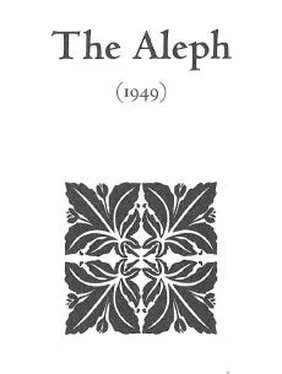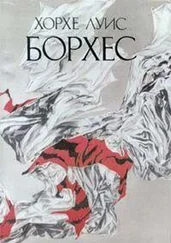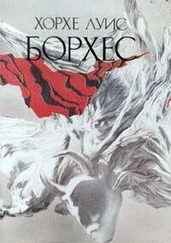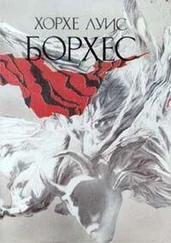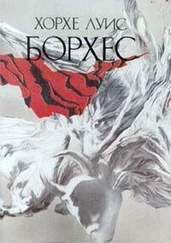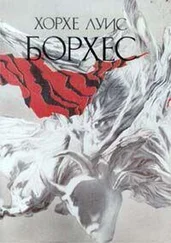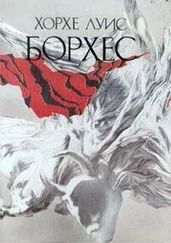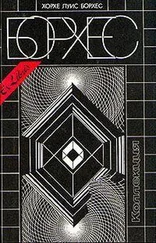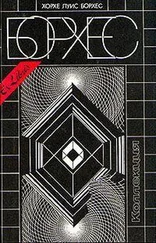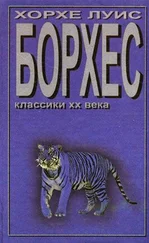Хорхе Борхес - Collected Fictions
Здесь есть возможность читать онлайн «Хорхе Борхес - Collected Fictions» весь текст электронной книги совершенно бесплатно (целиком полную версию без сокращений). В некоторых случаях можно слушать аудио, скачать через торрент в формате fb2 и присутствует краткое содержание. Год выпуска: 1999, ISBN: 1999, Издательство: Penguin (UK), Жанр: Старинная литература, на английском языке. Описание произведения, (предисловие) а так же отзывы посетителей доступны на портале библиотеки ЛибКат.
- Название:Collected Fictions
- Автор:
- Издательство:Penguin (UK)
- Жанр:
- Год:1999
- ISBN:9780140286809
- Рейтинг книги:5 / 5. Голосов: 1
-
Избранное:Добавить в избранное
- Отзывы:
-
Ваша оценка:
- 100
- 1
- 2
- 3
- 4
- 5
Collected Fictions: краткое содержание, описание и аннотация
Предлагаем к чтению аннотацию, описание, краткое содержание или предисловие (зависит от того, что написал сам автор книги «Collected Fictions»). Если вы не нашли необходимую информацию о книге — напишите в комментариях, мы постараемся отыскать её.
Collected Fictions — читать онлайн бесплатно полную книгу (весь текст) целиком
Ниже представлен текст книги, разбитый по страницам. Система сохранения места последней прочитанной страницы, позволяет с удобством читать онлайн бесплатно книгу «Collected Fictions», без необходимости каждый раз заново искать на чём Вы остановились. Поставьте закладку, и сможете в любой момент перейти на страницу, на которой закончили чтение.
Интервал:
Закладка:
* Maldonado: The Maldonado was a creek that at the time of this story (and many others of JLB's stories) marked the northern boundary of the city of Buenos Aires. The neighborhood around this area was called Palermo, or also Maldonado. This story evokes its atmosphere at one period (perhaps partly legendary); the Maldonado (barrio) was a rough place, and the creek was terribly polluted by the tanneries along its banks.
* Don Nicolas Paredes... Morel: Paredes was a famous knife fighter and ward boss for the conservative party in Palermo; Morel was another famed political boss, or caudillo.
* I couldn't say whether they gutted him: Here and elsewhere in Borges (one thinks, of course, especially of the story tided " The Story from Rosendo Juárez" in the volume Brodie's Report and the story in this volume tided "The Cruel Redeemer Lazarus Morell"), a corpse is gutted, or somebody thinks about gutting it. This, according to folk wisdom, is to keep the body from floating up and revealing the murder before die culprit has had good time to get away. Apparently a gutted body did not produce as much gas, or the gas (obviously) would not be contained in an inner cavity. Thus there is an unacknowledged "piece of information" here that the ruffians of the Maldonado and other such neighborhoods tacitly shared—tacitly because it was so obvious that no one needed to spell it out.
Et cetera
A THEOLOGIAN IN DEATH
* Attribution: The Swedenborg Concordance: A Complete Work of Reference to the Theological Writings of Emanuel Swedenborg, based on the original Latin writings of the author, compiled, edited, and translated by the Rev. John Faulkner Potts, B. A., 4 vols. (London: Swedenborg Society, 1888). The text quoted here appears in the index (p. 622 of the appropriate volume) under "Melancthon" and is a mixture of the entries indicating two different Swedenborg texts: A Continuation of the Last Judgment and The True Christian Religion. The reader may find the text under "C. J. 47" and "1.797, 1-4." The full entry on Melancthon in the Concordance runs to p. 624.
THE CHAMBER OF STATUES
* Attribution: Freely taken from Sir Richard Burton's Book of the Thousand Nights and a Night (New York: Heritage Press, 1934 [1962] ), pp. 1319-1321. The reader is referred to A Note on the Translation for more detailed comment on JLB's and the translator's uses of translations.
THE STORY OF THE TWO DREAMERS
* Attribution: This is freely adapted from a different version of the 1001 Nights, Edward William Lane's The Arabian Nights Entertainments —or The Thousand and One Nights (New York: Tudor Pubi.,1927), p. 1156. There are several other editions of this work, so the reader may find the tale in another place; Lane does not divide his book quite in the way JLB indicates.
THE MIRROR OF INK
* Attribution: One would not want to spoil JLB's little joke, if joke it is, but others before me have pointed out the discrepancy between this attribution and the fact. This story appears nowhere in Burton's Lake Regions and only sketchily in the volume that di Giovanni and many others give as the source: Edward William Lane's Manners and Customs of the Modern Egyptians (1837). Nonetheless, where Borges does seem to be translating (or calquing) the words of the last-named book, I have incorporated Lane's wording and word choices.
MAHOMED'S DOUBLE
* Attribution: Emanuel Swedenborg, The True Christian Religion, containing the Universal Theology of the New Church, foretold by the Lordm Daniel VII, 13, 14, and in the Apocalypse XXI, 1, 2, translated from the Latin of ES (NewYork: American Swedenborg Printing and Publishing Society, 1886),ÎJ.829-830.
Index of Sources
* Source for "The Improbable Impostor Tom Castro": The source given by Borges here is the PhilipGosse book The History of Piracy; as one can clearly see, it is the same source cited for "The Widow Ching—Pirate," just below it. In my view, this attribution is the result of an initial error seized upon by Borges for another of his "plays with sources"; as he subsequently admitted freely, and as many critics have noted, much of this story comes from the Encyclopcedia Britannica, Eleventh Edition, in the article titled "Tichborne Claimant." Here again, where JLB is clearly translating or calquing that source, I have followed it without slavish "transliteration" of JLB's Spanish.
* Source for "The Disinterested Killer Bill Harrigan": Neither the Walter Noble Burns book nor the Frederick Watson book contains anything remotely approaching the story given by Borges here. Some details are "correct" (if that is the word), such as Billy's long and blasphemous dying, spewing Spanish curses, but little in the larger pattern of the "biography" seems to conform to "life." While Borges claimed in the "Autobiographical Essay" (written with Norman Thomas diGiovanni and published in The Aleph and Other Stories [1970]) that he was "in flagrant contradiction" of his "chosen authorities]," the truth is that he followed the authorities fairly closely for all the characters herein portrayed except that of Billy the Kid. He did, of course, "change and distort" the stories to suit his own purposes, but none is so cut from whole cloth as that of this gunfighter of the Wild West. The lesson in the "Autobiographical Essay" is perhaps that JLB's predilection for the red herring was lifelong.
Notes to Fictions ("The Garden of Forking Paths" and "Artifices")
* Title: First published as Ficciones (1935-1944) by Editorial Sur in1944, this book was made up of two volumes: El jardín de senderosque sebifurcan ("The Garden of Forking Paths"), which had originally been published in 1941-1942, and Artificios ("Artifices"), dated 1944 and never before published as a book. Each volume in the 1944 edition had its own title page and its own preface. (In that edition, and in all successive editions, The Garden of Forking Paths included the story"El acercamientoa Al-motasim" (The Approach to Al-Mu'tasim"), collected first in Historia de la eternidad ("History of Eternity"), 1936, and reprinted in each successive edition of that volume until 1953; this story now appears in the Obras Completas in Historia de la eternidad, but it is included here as a "fiction" rather than an "essay") In 1956 Emecé published a volume titled Ficciones, which was identical to the 1944 Editorial Sur edition except for the inclusion in Artifices of three new stories ("The End," "The Cult of the Phoenix," and "The South") and a "Postscript" to the 1944 preface to Artifices. It is this edition of Fictions, plus "The Approach to Al-Mu'tasim," that is translated for this book.
THE GARDEN OF FORKING PATHS
Foreword
* The eight stories: The eighth story, here printed as the second, "The Approach to Al-Mu'tasim," was included in all editions subsequent to the 1941-1942 original edition. It had originally been published (1936) in Historia de la eternidad ("A History of Eternity"). Ordinals and cardinals used in the Foreword have been adjusted to reflect the presence of this story.
* Sur: "[T]he most influential literary publication in Latin America" (Rodriguez Monegal, p. 233), it was started by Victoria Ocampo, with the aid of the Argentine novelist Eduardo Malica and the American novelist Waldo Frank. Borges was one of the journal's first contributors, certainly one of its most notable (though Sur published or discussed virtually every major poet, writer, and essayist of the New or Old World) and he acted for three decades as one of its "guardian angels." Many of JLB's fictions, some of his poetry, and many critical essays and reviews appeared for the first time in the pages of Sur.
Читать дальшеИнтервал:
Закладка:
Похожие книги на «Collected Fictions»
Представляем Вашему вниманию похожие книги на «Collected Fictions» списком для выбора. Мы отобрали схожую по названию и смыслу литературу в надежде предоставить читателям больше вариантов отыскать новые, интересные, ещё непрочитанные произведения.
Обсуждение, отзывы о книге «Collected Fictions» и просто собственные мнения читателей. Оставьте ваши комментарии, напишите, что Вы думаете о произведении, его смысле или главных героях. Укажите что конкретно понравилось, а что нет, и почему Вы так считаете.
